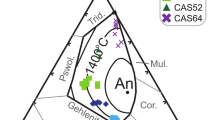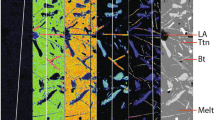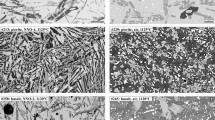Abstract
We present new partition coefficients for the REE, HFSE, Sn, In, Ga, Ba, Pt and Rh between clinopyroxene, olivine and basaltic melt as a function of crystal chemistry and melt composition at temperatures of 1190–1300 °C and 1-bar pressure. Two components, namely \(\mathrm {Al_2O_3}\) and \(\mathrm {Na_2O}\), were chosen to be investigated since they are known to affect the structure of silicate melts and especially clinopyroxene crystal chemistry. The amount of \(^{[4]}\mathrm{Al}\) in clinopyroxene will result in an increase of \(D_i^\mathrm{{cpx/melt}}\) even after applying a correction factor to account for the effect of melt polymerization. Moreover, the positive correlation between \(^{[4]}\mathrm{Al}\) and \(D_i^\mathrm{{cpx/melt}}\) is not restricted to the REE, but also applies for Sn, Ga, In, and Ba. The addition of up to 2.6 wt% \(\mathrm {Na_2O}\) to the silicate melt universally increases the \(D_i^\mathrm{{cpx/melt}}\) without any concomitant change in crystal chemistry or a significant effect in melt polymerization. This compositional effect is likely due to the ability of Na to break REE–Al complexes in the melt. Our results emphasize the importance of considering all variables that affect the behavior of trace elements in magmatic systems before applying the lattice strain model and derive meaningful results for the changes in the parameters of the crystallographic sites.













Similar content being viewed by others
References
Adam J, Green T (2006) Trace element partitioning between mica- and amphibole-bearing garnet lherzolite and hydrous basanitic melt: 1. Experimental results and the investigation of controls on partitioning behaviour. Contrib Mineral Petrol 152:1–17
Bennett SL, Blundy J, Elliott T (2004) The effect of sodium and titanium on crystal-melt partitioning of trace elements. Geochim Cosmochim Acta 68:2335–2347
Blundy J, Wood B (1994) Prediction of crystal-melt partition coefficients from elastic moduli. Nature 372:452–454
Blundy JD, Falloon TJ, Wood B, Dalton J (1995) Sodium partitioning between clinopyroxene and silicate melts. J Geophys Res 100:501–515
Blundy JD, Robinson JAC, Wood BJ (1998) Heavy REE are compatible in clinopyroxene on the spinel lherzolite solidus. Earth Planet Sci Lett 160:493–504
Blundy JD, Wood BJ (2003) Partitioning of trace elements between crystals and melts. Earth Planet Sci Lett 210:383–397
Chemia Z, Dolejs D, Steine-Neumann G (2015) Thermal effects of variable material properties and metamorphic reactions in a three component subducting slab. J Geophys Res B Solid Earth 1220:6823–6845
Davis FA, Humayun M, Hirschmann MM, Cooper RS (2013) Experimentally determined mineral/melt partitioning of first-row transition elements (FRTE) during partial melting of peridotite at 3 GPa. Geochim Cosmochim Acta 104:232–260
Duffy JA (1993) A review of optical basicity and its applications to oxidic systems. Geochim Cosmochim Acta 57:3961–3970
Dygert N, Liang Y, Hess P (2013) The importance of melt TiO\(_2\) in affecting major and trace element partitioning between Fe-Ti oxides and lunar picritic glass melts. Geochim Cosmochim Acta 106:134–151
Dygert N, Liang Y, Sun C, Hess P (2014) An experimental study of trace element partitioning between augite and Fe-rich basalts. Geochim Cosmochim Acta 132:170–186
Ertel W, O’Neill HStC, Sylvester PJ, Dingwell, DB (2006) Solubilities of Pt and Rh in a haplobasaltic silicate melt at 1300ÂřC. Geochim Cosmochim Acta 63:2439–2449
Evans TM, O’Neill HStC, Tuff J (2008) The influence of melt composition on the partitioning of REEs, Y, Sc, Zr and Al between forsterite and melt in the system CMAS. Geochim Cosmochim Acta 72:5708–5721
Farges F, Brown GE Jr, Rehr JJ (1996) Coordination chemistry of Ti(IV) in silicate glasses and melts: I. \(XAFS\) study of titanium coordination in oxide model compounds. Geochim Cosmochim Acta 60:3023–3038
Flemming RL, Luth RW (2002) \(^{29}\)Si MAS NMR study of diopside-Ca-Tschermak clinopyroxenes: detecting both tetrahedral and octahedral Al substitution. Am Mineral 87:25–36
Fonseca ROC, Mallmann G, Sprung P, Sommer JE, Heuser A, Speelmanns IM, Blanchard H (2014) Redox controls on tungsten and uranium crystal/silicate melt partitioning and implications for the U/W and Th/W ratio of the lunar mantle. Earth Planet Sci Lett 404:1–13
Gaetani GA (2004) The influence of melt structure on trace element partitioning near the peridotite solidus. Contrib Mineral Petrol 147:511–527
Gaetani GA, Grove TL (1995) Partitioning of rare earth elements between clinopyroxene and silicate melt: crystal-chemical controls. Geochim Cosmochim Acta 59:1951–1962
Gale A, Dalton CA, Langmuir CH, Schilling JG (2013) The mean composition of ocean ridge basalts. Geochem Geophys Geosyst 14:1–29
Hess PC (1991) The role of high field strength cations in silicate melts. In: Perchuk LL, Kushiro I (eds) Physical chemistry of magmas. Springer, New York, pp 152–191
Hill E, Wood BJ, Blundy JD (2000) The effect of Ca-Tschermaks component on trace element partitioning between clinopyroxene and silicate melt. Lithos 53:203–215
Huang F, Lundstrom CC, McDonough WF (2006) Effect of melt structure on trace-element partitioning between clinopyroxene and silicic, alkaline, aluminous melts. Am Mineral 91:1385–1400
Jarosewich E, Nelen J, Norberg JA (1980) Reference samples for electron microprobe analyses. Geostandard Newslett 4:43–47
Jenner FE, O’Neill HStC (2012) Analysis of 60 elements in 616 ocean floor basaltic glasses. Geochem Geophys Geosyst 13:1525–2027
Jochum KP, Weis U, Stoll B, Kuzmin D, Yang Q, Raczek I, Jacob DE, Stracke A, Birbaum K, Frick DA et al (2011) Determination of reference values for NIST SRM 610–617 glasses following ISO guidelines. Geostand Geoanal Res 35:397–429
Kohn SC, Schofield PF (1994) The importance of melt composition in controlling trace-element behaviour: an experimental study of Mn and Zn partitioning between forsterite and silicate melts. Chem Geol 117:73–87
Laurenz V, Fonseca ROC, Ballhaus C (2010) Solubility of palladium in picritic melts: 1. the effect of iron. Geochim Cosmochim Acta 74:2989–2998
Laurenz V, Fonseca ROC, Ballhaus C, Jochum KP, Heuser A, Sylvester PJ (2013) The solubility of palladium and ruthenium in picritic melts: 2. the effect of sulfur. Geochim Cosmochim Acta 108:172–183
Leitzke FP, Fonseca ROC, Michely LT, Sprung P, Münker C, Heuser A, Blanchard H (2016) The effect of titanium on the partitioning behavior of high-field strength elements between silicates, oxides and lunar basaltic melts with applications to the origin of mare basalts. Chem Geol 440:219–238
Longerich HP, Jackson SE, Günther D (1996) Inter-laboratory note. Laser ablation inductively coupled plasma mass spectrometric transient signal data acquisition and analyte concentration calculation. J Anal At Spectrom 11:899–904
Lundstrom CC, Shaw HF, Ryerson FJ, Phinney DL, Gill JB, Williams Q (1994) Compositional controls on the partitioning of U, Th, Ba, Pb, Sr and Zr between clinopyroxene and haplobasaltic melts: implications for uranium series disequilibria in basalts. Earth Planet Sci Lett 128:407–423
Lundstrom CC, Shaw HF, Ryerson FJ, Williams Q, Gill J (1998) Crystal chemical control of clinopyroxene-melt partitioning in the Di-Ab-An system: implications for elemental fractionations in the depleted mantle. Geochim Cosmochim Acta 62:2849–2862
Mallmann G, Fonseca ROC, Silva AB (2014) An experimental study of the partitioning of trace elements between rutile and silicate melt as a function of oxygen fugacity. An Acad Bras Cienc 86:1609–1629
Mallmann G, O’Neill HStC (2009) The crystal/melt partitioning of V during mantle melting as a function of oxygen fugacity compared with some other elements (Al, P, Ca, Sc, Ti, Cr, Fe, Ga, Y, Zr and Nb). J Petrol 50:1765–1794
Mallmann G, O’Neill HStC (2013) Calibration of an empirical thermometer and oxybarometer based on the partitioning of Sc, Y and V between olivine and silicate melt. J Petrol 54:933–949
Malvin DJ, Drake MJ (1987) Experimental determination of crystal/melt partitioning of Ga and Ge in the system forsterite-anorthite-diopside. Geochim Cosmochim Acta 51:2117–2128
Marquardt DW (1963) An algorithm for least-squares estimation of nonlinear parameters. J Soc Ind Appl Mech 11:431–441
Mills KC (1998) The influence of structure on the physico-chemical properties of slags. ISIJ Int 33:148–155
Mollo S, Blundy JD, Iezzi G, Scarlato P, Langone A (2013) The partitioning of trace elements between clinopyroxene and trachybasaltic melt during rapid cooling and crystal growth. Contrib Mineral Petrol 166:1633–1654
Moretti R (2005) Polymerisation, basicity, oxidation state and their role in ionic modelling of silicate melts. Ann Geophys Italy 48:583–608
Mysen BO (1990) Relationships between silicate melt structure and petrologic processes. Earth Sci Rev 27:281–365
Mysen BO (2004) Element partitioning between minerals and melt, melt composition, and melt structure. Chem Geol 213:1–16
O’Neill HStC, Berry AJ, Eggins SM (2008) The solubility and oxidation state of tungsten in silicate melts: implications for the comparative chemistry of W and Mo in planetary differentiation processes. Chem Geol 255:346–359
O’Neill HStC, Eggins SM (2002) The effect of melt composition on trace element partitioning: an experimental investigation of the activity coefficients of FeO, NiO, CoO, \(\rm {MoO_2}\) and \(\rm {MoO_3}\) in silicate melts. Chem Geol 186:151–181
O’Neill HStC, Palme H (1998) Composition of the silicate Earth: implications for accretion and core formation. In: Jackson I (ed) The Earth’s mantle: structure, composition and evolution. Cambridge University Press, Cambridge, pp 3–126
Onuma N, Higuchi H, Wakita H, Nagasawa H (1968) Trace element partitioning between two pyroxenes and the host lava. Earth Planet Sci Lett 5:47–51
Ponader CW, Brown GE (1998) Rare earth elements in silicate glassmelt systems: I. Effects of composition on the coordination environments of La, Gd, and Yb. Geochim Cosmochim Acta 53:2893–2903
Prowatke S, Klemme S (2005) Effect of melt composition on the partitioning of trace elements between titanite and silicate melt. Geochim Cosmochim Acta 69:695–709
Ryerson FJ, Hess PC (1978) Implication of liquid-liquid distribution coefficients to mineral-liquid partitioning. Geochim Cosmochim Acta 42:921–932
Schosnig M, Hoffer E (1998) Compositional dependence of REE partitioning between diopside and melt at 1 atmosphere. Contrib Mineral Petrol 133:205–216
Shannon RD (1976) Revised effective ionic radii and systematic studies of interatomie distances in halides and chaleogenides. Acta Crystallogr A 32:751–767
Westrenen WV, Allan NL, Blundy JD, Purton JA, Wood BJ (2000) Atomistic simulation of trace element incorporation into garnets—comparison with experimental garnet-melt partitioning data. Geochim Cosmochim Acta 64:1629–1639
Westrenen WV, Wood BJ, Blundy JD (2001) A predictive thermodynamic model of garnet-melt trace element partitioning. Contrib Mineral Petrol 142:219–234
Wood BJ, Blundy JD (1997) A predictive model for rare earth element partitioning between clinopyroxene and anhydrous silicate melt. Contrib Mineral Petrol 129:166–181
Acknowledgements
We are grateful to two anonymous reviewers for their comments, which greatly improved the manuscript, and to H. Keppler for his editorial handling. We thank N. Jung, T. Schulz, D. Lülsdorf and K. Brückel for their technical support at the University of Bonn. We are indebted to Chris Ballhaus for discussion, comments and suggestions. R.F. acknowledges financial support from the Deutsche Forschungsgemeinschaft (via DFG Grant FO 698/3). F.P.L. was supported by a PhD scholarship from DAAD/CNPq (Grant 248562/2013-4). This manuscript is contribution no. 39 of the LA-ICP-MS laboratory of the Steinmann Institute for Geosciences, University of Bonn.
Author information
Authors and Affiliations
Corresponding author
Additional information
Communicated by Othmar Müntener.
Electronic supplementary material
Below is the link to the electronic supplementary material.
Rights and permissions
About this article
Cite this article
Michely, L.T., Leitzke, F.P., Speelmanns, I.M. et al. Competing effects of crystal chemistry and silicate melt composition on trace element behavior in magmatic systems: insights from crystal/silicate melt partitioning of the REE, HFSE, Sn, In, Ga, Ba, Pt and Rh. Contrib Mineral Petrol 172, 39 (2017). https://doi.org/10.1007/s00410-017-1353-1
Received:
Accepted:
Published:
DOI: https://doi.org/10.1007/s00410-017-1353-1




